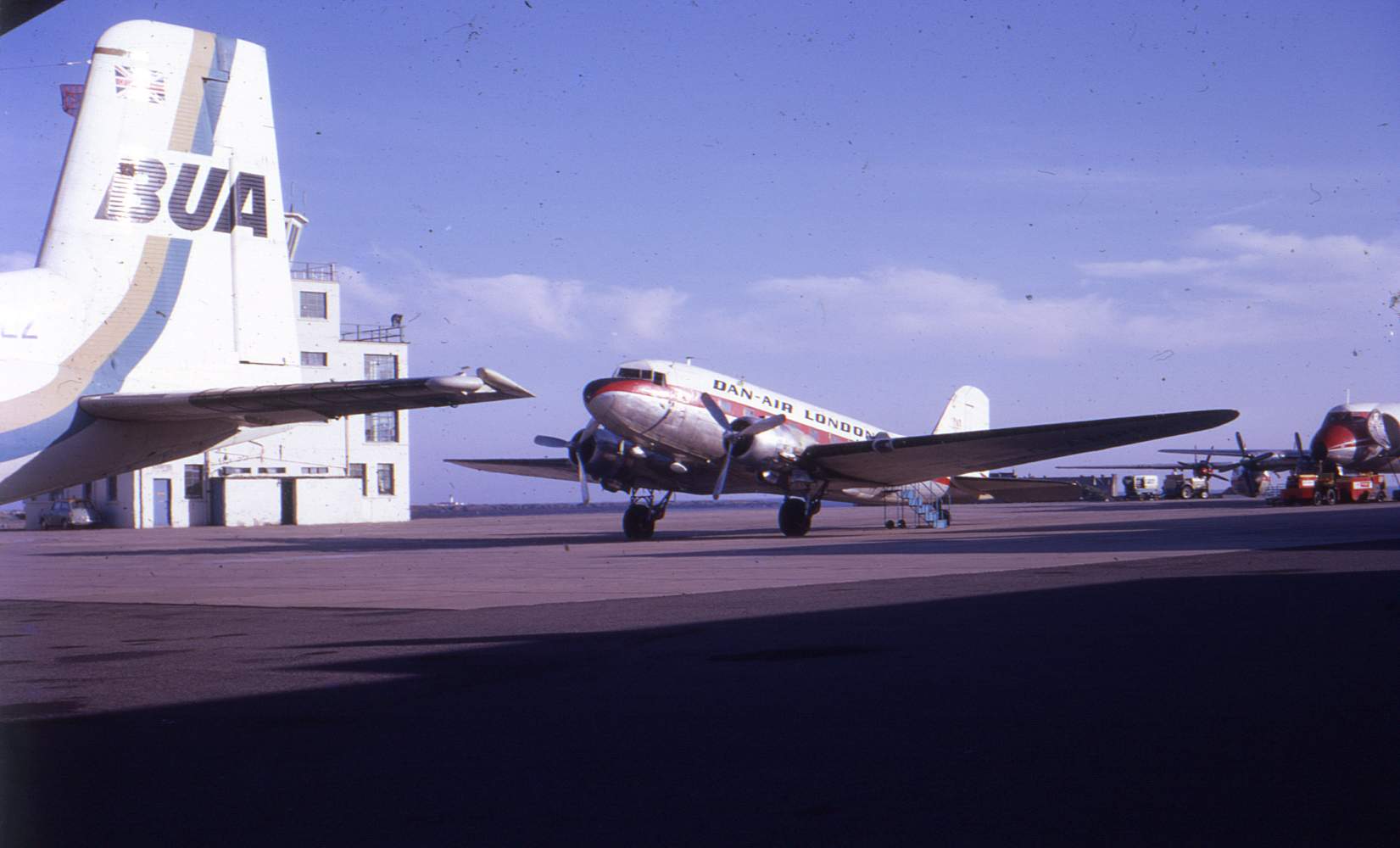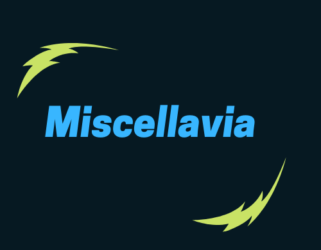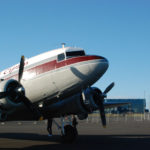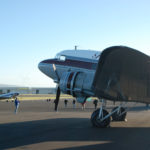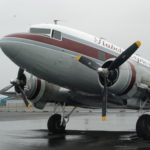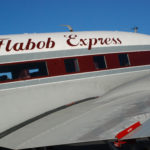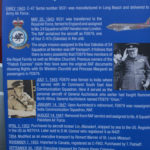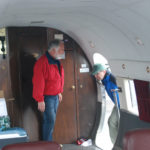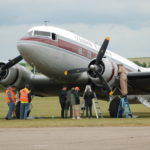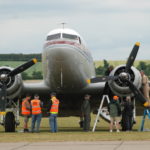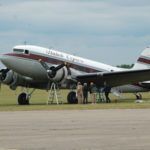The eight D-Day squadron Dakotas visiting Prestwick at the end of May 2019, en route to the Normandy commemoration, all had interesting histories. N103NA, Flabob Express, was a WW2 RAF veteran which had returned from war to spend many years in Canada. Her history has been complicated by her first civilian owner, the US aviation entrepreneur and past proprietor of Aero Spacelines, Lee Mansdorf. As revealed in JMG Gradidge’s research in Air Britain’s definitive history ‘The DC-3 and its predecessors’, Mansdorf bought a batch of seven Dakotas from the Pakistan Air Force in April 1952 and shipped them by sea to the USA. This may be indicative of the condition of the aircraft. Some 22 operational Dakotas were transferred to the PAF following the partition of India on 15th August 1947 but there were many others in varying states of repair at RAF FLCs ( ‘Field Liquidation Centres’ ) in the sub continent at the end of the WW2 Lend Lease scheme. Some of the aircraft disposals were less than regular and documentation and identification was occasionally blurred. This was the case with Mansdorf’s aircraft which, it appears, had all lost their data plates. In many countries this would be ignored but, for US registration, Mansdorf needed the construction number and the plate which confirmed it. Consequently, the Daks were ‘identified’ as being ex-RAF aircraft with consecutive identities KP265 to KP271 with consecutive construction numbers 33567 to 33573. This would be on the limits of credibility even if there weren’t other aircraft with those serials flying around – but there were! Mansdorf was lucky with 33570, KP268, which had been consigned to a FLC in 1947 and probably scrapped (ref 1). 33572, KP270, and 33573, KP271, had also disappeared following crashes in India. However, 33567, 33568, 33569 and 33571 were with RAF Maintenance Units in Britain en route to careers with the USAF (567) and Eagle Aviation (568) and Field Aircraft Services scrapyard (569 & 571). Although Field’s were involved with most of these aircraft, this could be expected as they were the main agent for PAF Dakota disposals. Hence, I’m sorry to say Mr Mansdorf, it is most likely that you picked your own serial numbers for this batch!
So, if construction number 33569 came to a sticky end at Croydon in July 1953, what was the past identity of ‘Flabob Express’?
It seems likely that N103NA started life as 42-23669, construction number 9531, part of US government contract AC-20669 which included this batch of 207 C-47A-30-DL aircraft, part of a larger order for 2954 C-47As produced at the Long Beach plant. So she was not built at the Oklahoma City plant as her plate would suggest, but is a true California girl. Delivered on 12th May 1943, she was supplied to the RAF under the Lend Lease program as FD879 on 20th May 1943. Initially supplied to 24 squadron at Hendon, they were in the process of splitting their fleet with the majority of Dakotas going to 512 squadron. However, 24 sqdn were charged with operating VIP aircraft and they retained 4 Dakotas along with the newly introduced 4-engined Avro Yorks. Churchill’s personal aircraft for much of the following period was the York ‘Ascalon’ but past owners of FD879 say they have seen Log books which show that both Churchill and Princess Margaret flew in this C-47. FD879 was certainly fitted-out for VIP transport and, in early July 1943, she was delivered to India as the personal transport of General Sir Claude Auchinleck, Commander-in-Chief of the British Army in India. The Dakota operated with the name ‘Orion’ – other South East Asia Command (SEAC) Dakotas were named ‘Mercury’, ‘Sister Ann’, ‘Hapgift’ (all Mountbatten’s Dakotas), ‘Bambi’ (Lord Killearn) and ‘Vanda’. Following the end of the war, Auchinleck retired on 14th January 1947 before the partition of India on 15th August 1947. Upon Auchinleck’s departure, FD879 passed to the India Communications Squadron of South East Asia Command and, following partition, to 6 Squadron, Pakistan Air Force at Mauripur, Karachi. Currently named the Masour Air Base, this is one of the largest military fields in Asia and, since being established by the RAF, had always been a major staging post. Many of the PAF Dakotas, serviceable and awaiting attention, no doubt accumulated here and, by 1952, this is where Lee Mansdorf will have acquired his ‘Magnificent 7’ Dakotas-with-uncertain-histories.
The panacea of surplus C-47s at the end of WW2 was beginning to dry-up by the early fifties. Companies like Scottish Aviation at Prestwick and Canadair at Cartierville, Montreal had hoovered-up huge stocks of redundant airframes, parts new and used and even tooling and drawings. Scottish Aviation had produced a number of executive DC-3s from the ex-military stock and several smaller specialist companies had grown-up in the USA. Lee Mansdorf was an aviation entrepreneur and had discovered the pool of ex-RAF SEAC Dakotas parked-up in India and Pakistan. The commercial transactions which surrounded the disposal of these aircraft since the end of WW2 would, in themselves, make a good basis for a fast-moving novel of political intrigue and crime. Remmert-Werner in St.Louis, Missouri, was a specialist converter which, by the fifties, was scouring the World for suitable airframes to upgrade to executive DC-3s. One shipment of Dakotas from Turkey took 3 years to arrive by rail and sea, so Lee Mansdorf’s newly registered seaborne ex-PAF Dakota was far from unusual. FD879 had initially been registered N2701A with its shady construction plate. Re-registered N42F it was sold to D.W.Connor in 1954 and was transferred to St.Louis for conversion to an executive standard. It’s not known whether her previous identity as Auchinlech’s VIP aircraft ‘Orion’ offered any advantages for her new role. With her conversion completed, the aircraft was rolled out on 7th November 1955 with a new plate promoting the incorrect serial 33569. She was imported to Canada as CF-IKD, reportedly registered to T.Flahieff, and possibly operated by Shell Oil.
On 30th September 1958 CF-IKD was sold to the Ontario Paper Mill of Thorold and moved to a new base at Malton Airfield, Toronto. This airfield, now Lester Pearson International, had a long association with the DC-3, the first aircraft to land when the airport opened in 1937. The paper company was a subsidiary of the Chicago Tribune newspaper and the pilots Fred Hotson and Norm Irwin spent a large part of their time flying ‘IKD between Malton, Chicago, New York and Dorval, Montreal, with the occasional side trip to the Bahamas.
On 15th April 1965 CF-IKD was sold to the Dominion Tar and Chemical Company of Montreal which, despite its name, was also closely associated with the paper and pulp industry. After a couple of years, on 10th August 1967 the DC-3 moved on to Laurentide Aviation, also in Montreal. Laurentide, founded in 1946, was reputedly Canada’s oldest commercial flying school and was based at Cartierville Airport, the same field which had been Canadair’s C-47/ DC-3 Conversion Plant at the end of the war. In 1971 Laurentide moved to their own airfield at Les Cedres to the west of Dorval and, on 19th February, CF-IKD was sold to the short-lived third level operator Eden Air (Canada) of Pointe Claire, Montreal.
After ten months with Eden, CF-IKD moved on 21st December 1971 to the Ilford Riverton Airways family in Winnipeg, Manitoba to become a fully-fledged bush pilot aircraft. Ilford had been formed in 1953, Riverton in 1958 and they amalgamated in 1960. By the early 1980s, their staff of around 30 operated a fleet that included four Dakotas, a PBY-5 Canso and a Beech 18 to destinations in Northern Manitoba and the Arctic. By May 1985, our subject’s registration had been adapted to the new Canadian system as C-FIKD and, shortly afterwards, Northland Airways joined the group in 1986. The Dakotas were rebranded with ‘Northland Air Manitoba’ titles. Further changes occurred in 1991 with the airline simplifying its name to Air Manitoba to coincide with the greater use of HS748 aircraft. C-FIKD was reported semi-derelict at Winnipeg in May 1992 but Dave Richardson’s photo on the Air Britain ABpic site was taken on the 4th July 1982 and suggests it was in good condition.
The following year, C-FIKD was exported to the USA on 16th February 1983, becoming N103NA for the first time with Nostalgic Airways at Kidron, Ohio, a company which planned to fly sightseeing tours. The missionary organisation MMS Aviation assisted with preparation for the US register and a CofA was issued in May 1993. Insurance costs proved to be an insurmountable problem for Nostaligic and the aircraft moved-on in January 1995 to Thomas L.Brown of Huntingdon Beach California still wearing her blue and red Air Manitoba colours.
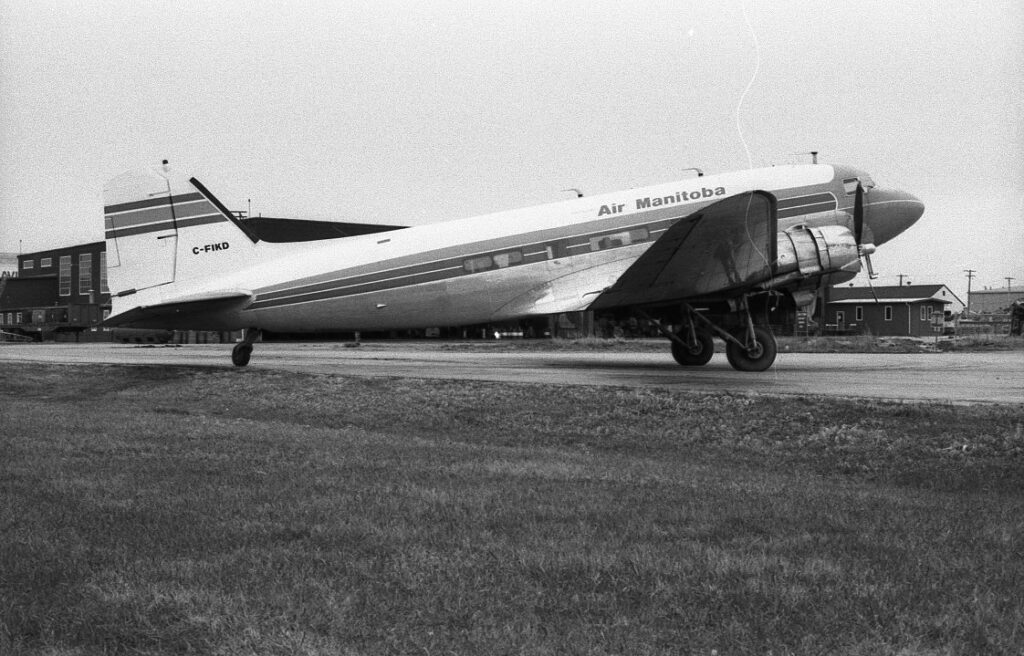
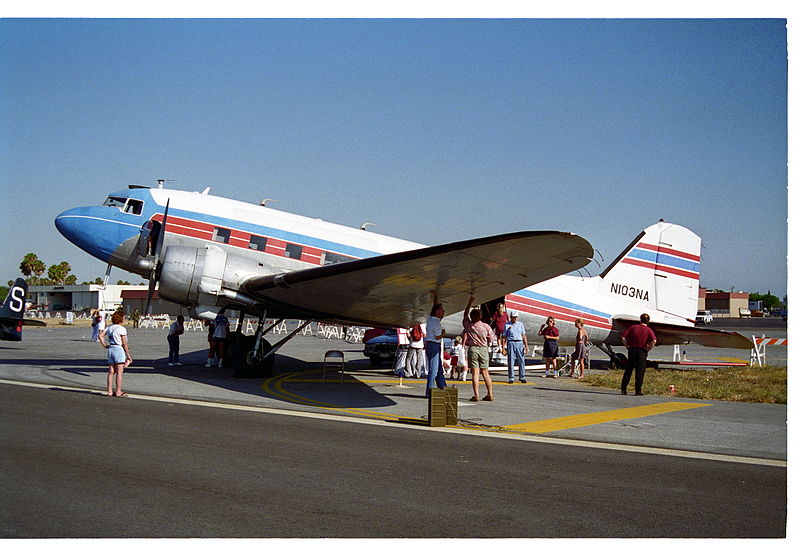
By 24th March 1997, the aircraft was operated under the ‘Classic Express Airways’ name, again from Huntingdon Beach. By May 2002, the owners are recorded as being Newport Signal Air Inc of Costa Mesa, California although she was still operated by Classic Express from Chino. After five years of negligible operation at Chino, on April 20th 2006 N103NA was flown to Flabob Airport, piloted by ex-USAF fighter pilot Jon Goldenbaum. The aircraft had been donated by Mr Jerry Barto to the charitable group Flabob Aviation Associates headed by Goldenbaum. Their aim is to encourage aviation education and aircraft restoration. A trio of engineers set to work rebuilding the Express’s wingtip and ailerons and, on completion, the aircraft was certified by Joe Garcia, a DC-3 expert based at Flabob. Since 20th February 2007 N103NA has been registered to Flabob Aviation Associates and remains based at the Riverside airport founded in 1925 by FLAvio Madariaga and BOB Bogan as a centre for private, experimental and historic aviation.
Considerable investment was made in the aircraft prior to departure for Europe with the D-Day Squadron. Twin Garmin GPS receivers and Electronic Flight Displays were installed at a cost of around $75,000. Crew Chief at Flabob was Don ‘Pops’ Newman and pilots for the crossing were brothers Bob, Bill and John Tymczyszyn, Matt Walker, Joe Fisher, Hualdo Mendoza and Brian Maisler.
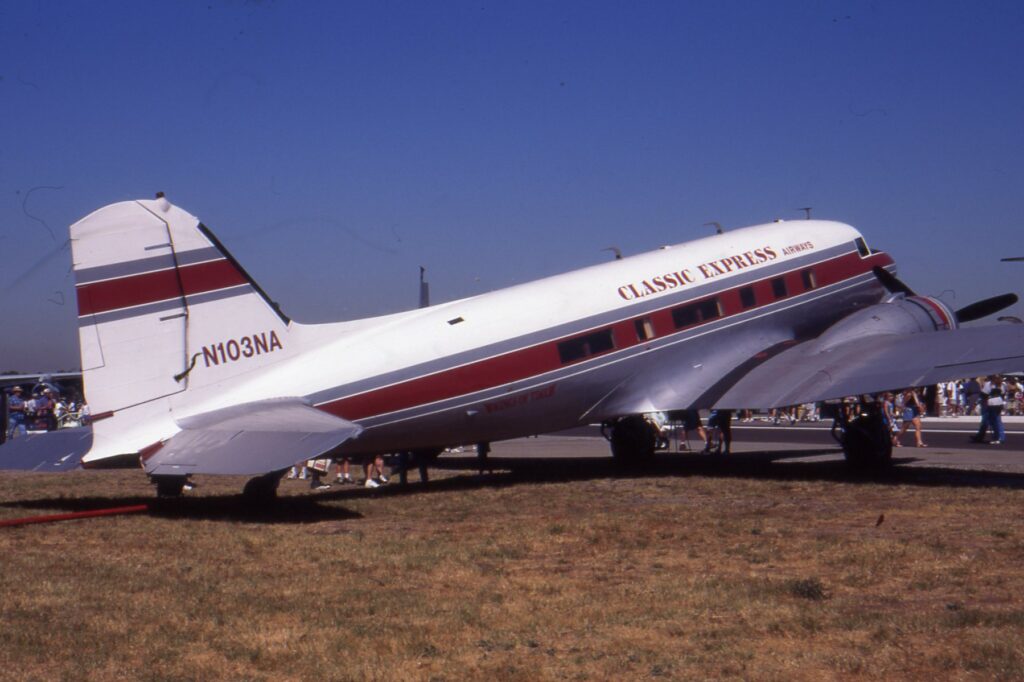
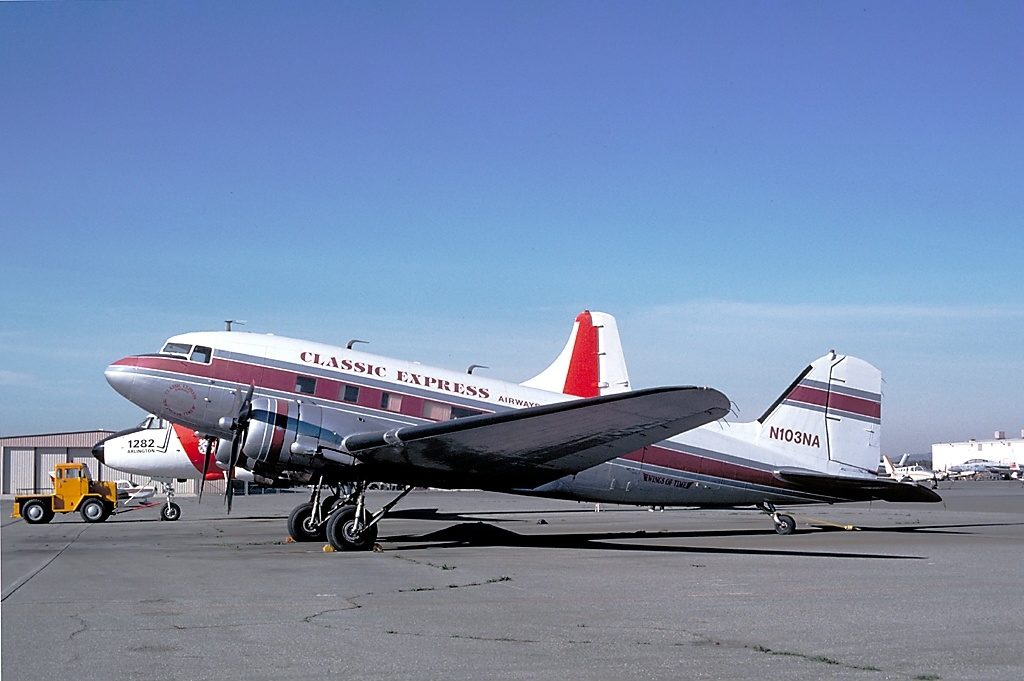
Travel with D-Day Squadron
Even before Flabob Express started her Atlantic Crossing to the UK she had to traverse an entire continent. N103NA departed her home at Flabob Airport on May 6th, a full month before the D-Day commemoration. Flying east, she called at Yuma, Arizona, and Dalhart, Texas, before arriving in St.Louis on 7th May. Amazingly, it was 64 years since ‘Flabob Express’ had been converted at Remmert Werner in St.Louis at the start of her civilian career. On May 8th N103NA lifted from St.Louis and flew to Oxford, Connecticut, via Syracuse, New York. Oxford (KOXC) was the gathering point for D-Day squadron and Flabob Express had made it there quickly and without problems. The rest of the squadron assembled over the next few days and, on May 18th, they took part in the flypast of the Statue of Liberty and over New York City. The next day, May 19th, Flabob Express left Oxford with other squadron members bound for Presque Isle in Maine and then Goose Bay, Canada (CYYR). Flabob Express arrived in Goose Bay at 18:07 local time on 19th May but the weather on the ‘Blue Spruce Route’ was not looking good. With snow, sleet and low temperatures, the aircraft remained ‘socked-in’ at Goose Bay until May 22nd. Flabob was the first aircraft to lift-off from Goose Bay at just before 08:00 ADT on 22nd, heading at 10,000′ altitude for Narsarsuaq, Greenland (BGBW) which was reached just after 10:00 local time. On May 23rd, N103NA was on her way to the airport at Reykjavik, Iceland (BIRK) before pressing on to Prestwick, Scotland (EPIK) the following day. After participating in an evening photo shoot at Prestwick on 24th and the D-Day Squadron Air Show on the following day, Flabob Express departed Prestwick at 12:45 BST on 27th May and arrived at Duxford (EGSU) at 14:40 having truly completed her Atlantic crossing.
There were a few days available for maintenance prior to the D-Day commemoration events and, on June 1st, the D-Day Squadron delighted visitors to the Shuttleworth Trust at Old Warden airfield by visiting their display day. It was only a month or so earlier that Old Warden had received its first recorded Dakota landing, quite an event at the small grass strip. Consequently, the arrival of Flabob and six of her sisters created excitement off the scale!
The Duxford D-Day commemoration flights went off well on June 4th but, when time came for the departure to Caen on the formation flight scheduled for June 5th, Flabob Express had serviceability issues and had to stay behind. ‘Little Egypt’ was also still at Duxford, with more serious engine issues, but it was unfortunate for the crew that Flabob Express remained on the ground and was only able to join the rest of the squadron later when her carburetor problem had been solved. After a number of circuits of Duxford on the evening of June 6th, she was pronounced fit to fly.
Fortunately, N103NA was able to catch up with the rest of the team at Caen Carpiquet and remained in France until June 9th. She departed Caen at 15:09 on 9th and arrived at the US airbase at Wiesbaden at 18:12 the same evening. The Squadron enjoyed their stay at Wiesbaden, where a very successful open day hosted 45-50,000 visitors, before moving on to various destinations in Germany to help commemorate the 70th anniversary of the Berlin Airlift. Flabob Express departed Wiesbaden at 08:59 on June 13th for the flight to Schoenhagen where she landed at 11:18. The following day, N103NA took part in the Berlin Airlift flypast flying alongside Betsy’s Biscuit Bomber which was carrying the original ‘Candy Bomber’ Gail Halvorsen. The aircraft had planned to drop thousands of candy parachutes donated by Flabob supporter Herm Rowland but Berlin City Council would not permit this and the aircraft were also unable to land at Berlin Airports.
Flabob Express began her return journey to the USA shortly afterwards, transiting through Prestwick, where she made a sound landing in windy conditions on June 16th, en route to Reykjavik. Although fuel supply on the ‘Blue Spruce Route’ was becoming an issue, N103NA arrived in Goose Bay, Canada on June 19th and was safely back on the ground in the USA at Oshkosh on June 23rd. She later took part in the Oshkosh fly-in on July 27th and 28th, a celebration of her amazing Atlantic adventure. Thanks to the pilots, mechanics and all those supporting the D-Day squadron which made this great event possible and allowed us two opportunities to see ‘Flabob Express’ in Prestwick.
Hits: 855
